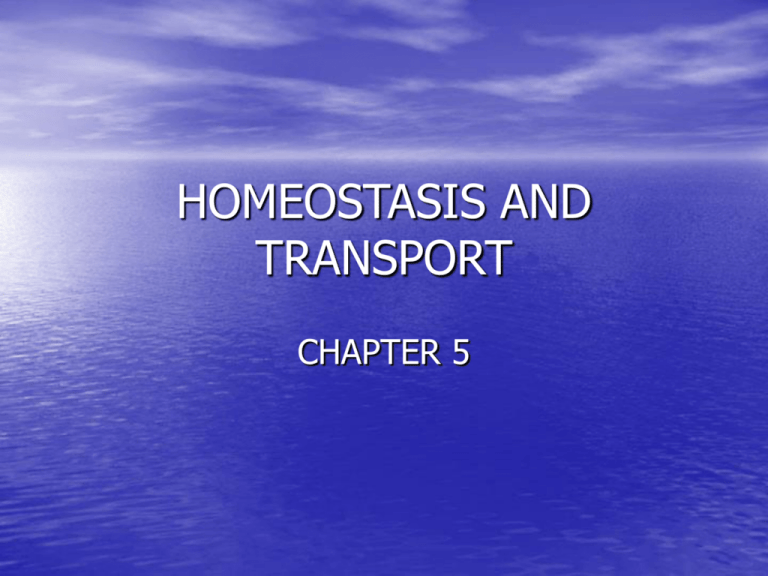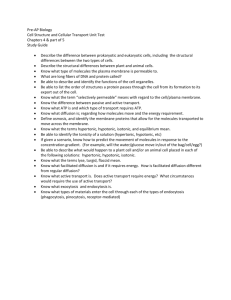HOMEOSTASIS AND TRANSPORT
advertisement

HOMEOSTASIS AND TRANSPORT CHAPTER 5 CELL MEMBRANES • Cell membranes help organisms maintain homeostasis by controlling what substances may enter or leave cells • To stay alive, a cell must exchange materials such as food, water, & wastes with its environment • These materials must cross the cell or plasma membrane • Small molecules like water, oxygen, & carbon dioxide can move in and out freely • Large molecules like proteins & carbohydrates cannot move easily across the plasma membrane • The Cell Membrane is semipermeable or selectively permeable only allowing certain molecules to pass through PASSIVE TRANSPORT • DEF = when substances move across a cell membrane without the use of energy by the cell • Three types: – Diffusion – Osmosis – Facilitated diffusion DIFFUSION • Diffusion is the movement of small molecules from an area of higher concentration to an area of lower concentration • This difference in the concentration of molecules across a membrane is called a concentration gradient – Diffusion always occurs down a concentration gradient (water moves from an area where it is more concentrated to an area where it is less concentrated) • Diffusion is driven by the kinetic energy of the molecules • Kinetic energy keeps molecules in constant motion causing the molecules to move randomly away from each other in a liquid or a gas • The rate of diffusion depends on temperature, size of the molecules, & type of molecules diffusing • Molecules diffuse faster at higher temperatures than at lower temperatures • Smaller molecules diffuse faster than larger molecules • Most short-distance transport of materials into & out of cells occurs by diffusion • Diffusion continues until the concentration • of the molecules is the same on both sides of a membrane When a concentration gradient no longer exists, equilibrium has been reached but molecules will continue to move equally back & forth across a membrane • simulation OSMOSIS • The diffusion of water across a semipermeable • • • • • membrane is called osmosis Diffusion occurs from an area of high water concentration (less solute) to an area of lower water concentration (more solute) Movement of water is down its concentration gradient & doesn’t require extra energy Cytoplasm is mostly water containing dissolved solutes Concentrated solutions have many solute molecules & fewer water molecules Water moves from areas of low solute concentration to areas of high solute concentration • Water molecules will cross membranes until the concentrations of water & solutes is equal on both sides of the membrane; called equilibrium • At equilibrium, molecules continue to move across membranes evenly so there is no net movement • simulation HYPERTONIC SOLUTION 1. Solute concentration outside the cell is higher (less water) 2. Water diffuses out of the cell until equilibrium is reached 3. Cells will shrink & die if too much water is lost 4. Plant cells become flaccid (wilt); called plasmolysis HYPOTONIC SOLUTION 1. Solute concentration greater inside the cell (less 2. 3. 4. 5. 6. 7. water) Water moves into the cell until equilibrium is reached Animal cells swell & burst (lyse) if they take in too much water Cytolysis is the bursting of cells Plant cells become turgid due to water pressing outward against cell wall Turgor pressure in plant cells helps them keep their shape Plant cells do best in hypotonic solutions ISOTONIC SOLUTION 1. Concentration of solutes same inside & outside the cell 2. Water moves into & out of cell at an equal rate so there is no net movement of water 3. Animal cells do best in isotonic solutions HOW CELLS DEAL W/OSMOSIS • The cells of animals • • on land are usually in isotonic environment (equilibrium) Freshwater organisms live in hypotonic environments so water constantly moves into their cells Unicellular freshwater organisms use energy to pump out excess water by contractile vacuoles • Plant cell walls prevent plant cells from bursting in hypotonic environments – Turgor pressure = the pressure that water molecules exert against the cell wall – Plasmolysis= when cells shrink away from the cell wall losing turgor pressure; why plants wilt • Some marine organisms can pump out excess salt • Some cells, like red blood cells, cannot compensate for change in solute concentrations because they don’t have contractile vacuoles, solute pumps or cell walls • Cytolysis= the bursting of a cell in a hypotonic solution FACILITATED DIFFUSION • Faster than simple diffusion • Considered passive transport because extra energy not • • • • used Occurs down a concentration gradient Involves carrier proteins embedded in a cell’s membrane to help move across certain solutes such as glucose Carrier molecules change shape when solute attaches to them Change in carrier protein shape helps move solute across the membrane CHANNEL PROTEINS • Channel proteins in the cell membrane form • • tunnels across the membrane to move materials Channel proteins may always be open or have gates that open & close to control the movement of materials; called gated channels Gates open & close in response to concentration inside & outside the cell ION CHANNELS • Provide small passage ways across cell • • membranes which ions can diffuse Each ion channel is specific for an ion Some are always open; some may open or close in response to stimuli – Stretching of cell membrane – Electrical signals – Chemicals • simulation ACTIVE TRANSPORT SEC. 5.2 ACTIVE TRANSPORT • DEF= REQUIRES CELL TO EXPELL ENERGY (ATP); WHEN MATERIALS HAVE TO MOVE UP THEIR CONCENTRATION GRADIENT; FROM AN AREA OF LOWER CONCENTRATION TO AN AREA OF HIGHER CONCENTRATION SODIUM-POTASSIUM PUMPS • A carrier protein • Transports Na+ ions and K+ ions up their concentration gradients • Sodium-Potassium pump moves 3 Na+ out for every 2 K+ into the cell – 1. Causes a difference in charge inside and outside the cell – 2. Difference in charge is called membrane potential • Ion pumps help muscle & nerve cells work • Plants use active transport to help roots absorb nutrients from the soil (plant nutrients are more concentrated inside the root than outside) • simulation BULK TRANSPORT • Moves large, complex molecules such as proteins across the cell membrane • Large molecules, food, or fluid droplets are packaged in membrane-bound sacs called vesicles • Endocytosis moves large particles into a cell Endocytosis cont. • Phagocytosis is one type of endocytosis – 1. Cell membrane extends out forming pseudopods (fingerlike projections) that surround the particle – 2. Membrane pouch encloses the material & pinches off inside the cell making a vesicle – 3. Vesicle can fuse with lysosomes (digestive organelles) or release their contents in the cytoplasm – 4. Used by ameba to feed & white blood cells to kill bacteria – 5. Known as "cell eating" Endocytosis cont. • Pinocytosis is another type of endocytosis – 1. Cell membrane surrounds fluid droplets – 2. Fluids taken into membrane-bound vesicle – 3. Known as "cell drinking" EXOCYTOSIS • Exocytosis is used to remove large products from the cell such as wastes, mucus, & cell products • Proteins made by ribosomes in a cell are packaged into transport vesicles by the Golgi Apparatus • Transport vesicles fuse with the cell membrane and then the proteins are secreted out of the cell (e.g. insulin) • Active transport video






